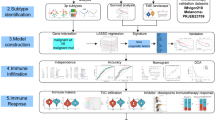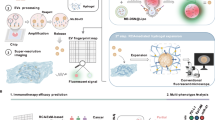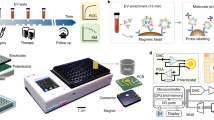Abstract
Sequencing of messenger RNA (mRNA) found in extracellular vesicles (EVs) in liquid biopsies can provide clinical information such as somatic mutations, resistance profiles and tumor recurrence. Despite this, EV mRNA remains underused due to its low abundance in liquid biopsies, and large sample volumes or specialized techniques for analysis are required. Here we introduce Self-amplified and CRISPR-aided Operation to Profile EVs (SCOPE), a platform for EV mRNA detection. SCOPE leverages CRISPR-mediated recognition of target RNA using Cas13 to initiate replication and signal amplification, achieving a sub-attomolar detection limit while maintaining single-nucleotide resolution. As a proof of concept, we designed probes for key mutations in KRAS, BRAF, EGFR and IDH1 genes, optimized protocols for single-pot assays and implemented an automated device for multi-sample detection. We validated SCOPE’s ability to detect early-stage lung cancer in animal models, monitored tumor mutational burden in patients with colorectal cancer and stratified patients with glioblastoma. SCOPE can expedite readouts, augmenting the clinical use of EVs in precision oncology.
This is a preview of subscription content, access via your institution
Access options
Access Nature and 54 other Nature Portfolio journals
Get Nature+, our best-value online-access subscription
$32.99 / 30 days
cancel any time
Subscribe to this journal
Receive 12 print issues and online access
$259.00 per year
only $21.58 per issue
Buy this article
- Purchase on SpringerLink
- Instant access to full article PDF
Prices may be subject to local taxes which are calculated during checkout






Similar content being viewed by others
Data availability
The mRNA target sequences were obtained from the National Center for Biotechnology Informationʼs Reference Sequence database (accession codes: NC_000002.12, NC_00007.14 and NC_000012.12). The primary data supporting assay characterization are accessible in a source data file and in Supplementary Information. Raw patient datasets generated and analyzed during this study are available from the corresponding authors upon reasonable request, subject to approval from the institutional review board of Massachusetts General Hospital (MGH) and the MGH Innovation Office. Data access requests will be considered from academic investigators without relevant conflicts of interest, for non-commercial use, who agree to non-distribution terms. Source data are provided with this paper.
References
Ignatiadis, M., Sledge, G. W. & Jeffrey, S. S. Liquid biopsy enters the clinic—implementation issues and future challenges. Nat. Rev. Clin. Oncol. 18, 297–312 (2021).
Heitzer, E., Haque, I. S., Roberts, C. E. S. & Speicher, M. R. Current and future perspectives of liquid biopsies in genomics-driven oncology. Nat. Rev. Genet. 20, 71–88 (2019).
Killingsworth, B., Welsh, J. A. & Jones, J. C. EV translational horizons as viewed across the complex landscape of liquid biopsies. Front. Cell Dev. Biol. 9, 556837 (2021).
Parikh, A. R. et al. Liquid versus tissue biopsy for detecting acquired resistance and tumor heterogeneity in gastrointestinal cancers. Nat. Med. 25, 1415–1421 (2019).
Pantel, K. & Alix-Panabières, C. Liquid biopsy and minimal residual disease—latest advances and implications for cure. Nat. Rev. Clin. Oncol. 16, 409–424 (2019).
Siravegna, G., Marsoni, S., Siena, S. & Bardelli, A. Integrating liquid biopsies into the management of cancer. Nat. Rev. Clin. Oncol. 14, 531–548 (2017).
Shao, H. et al. New technologies for analysis of extracellular vesicles. Chem. Rev. 118, 1917–1950 (2018).
Im, H. et al. Label-free detection and molecular profiling of exosomes with a nano-plasmonic sensor. Nat. Biotechnol. 32, 490–495 (2014).
Jo, A. et al. Inaugurating high-throughput profiling of extracellular vesicles for earlier ovarian cancer detection. Adv. Sci. 10, e2301930 (2023).
Dixson, A. C., Dawson, T. R., Di Vizio, D. & Weaver, A. M. Context-specific regulation of extracellular vesicle biogenesis and cargo selection. Nat. Rev. Mol. Cell Biol. 24, 454–476 (2023).
Skog, J. et al. Glioblastoma microvesicles transport RNA and proteins that promote tumour growth and provide diagnostic biomarkers. Nat. Cell Biol. 10, 1470–1476 (2008).
Vitale, S. R. et al. Detection of tumor-derived extracellular vesicles in plasma from patients with solid cancer. BMC Cancer 21, 315 (2021).
van de Haar, J. et al. Codon-specific KRAS mutations predict survival benefit of trifluridine/tipiracil in metastatic colorectal cancer. Nat. Med. 29, 605–614 (2023).
Shao, H. et al. Chip-based analysis of exosomal mRNA mediating drug resistance in glioblastoma. Nat. Commun. 6, 6999 (2015).
Park, J. et al. An integrated magneto-electrochemical device for the rapid profiling of tumour extracellular vesicles from blood plasma. Nat. Biomed. Eng. 5, 678–689 (2021).
Noerholm, M. et al. RNA expression patterns in serum microvesicles from patients with glioblastoma multiforme and controls. BMC Cancer 12, 22 (2012).
Wei, Z. et al. Coding and noncoding landscape of extracellular RNA released by human glioma stem cells. Nat. Commun. 8, 1145 (2017).
Hong, J. S., Son, T., Castro, C. M. & Im, H. CRISPR/Cas13a-based microRNA detection in tumor-derived extracellular vesicles. Adv. Sci. 10, e2301766 (2023).
Yan, H. et al. A one-pot isothermal Cas12-based assay for the sensitive detection of microRNAs. Nat. Biomed. Eng. 7, 1583–1601 (2023).
Ramshani, Z. et al. Extracellular vesicle microRNA quantification from plasma using an integrated microfluidic device. Commun. Biol. 2, 189 (2019).
Li, Y. et al. EV-origin: enumerating the tissue-cellular origin of circulating extracellular vesicles using exLR profile. Comput. Struct. Biotechnol. J. 18, 2851–2859 (2020).
Pickar-Oliver, A. & Gersbach, C. A. The next generation of CRISPR–Cas technologies and applications. Nat. Rev. Mol. Cell Biol. 20, 490–507 (2019).
Kaminski, M. M., Abudayyeh, O. O., Gootenberg, J. S., Zhang, F. & Collins, J. J. CRISPR-based diagnostics. Nat. Biomed. Eng. 5, 643–656 (2021).
Abudayyeh, O. O. & Gootenberg, J. S. CRISPR diagnostics. Science 372, 914–915 (2021).
Potapov, V. & Ong, J. L. Examining sources of error in PCR by single-molecule sequencing. PLoS ONE 12, e0169774 (2017).
Kebschull, J. M. & Zador, A. M. Sources of PCR-induced distortions in high-throughput sequencing data sets. Nucleic Acids Res. 43, e143 (2015).
Gootenberg, J. S. et al. Nucleic acid detection with CRISPR–Cas13a/C2c2. Science 356, 438–442 (2017).
Truong, N. P., Jia, Z., Burges, M., McMillan, N. A. & Monteiro, M. J. Self-catalyzed degradation of linear cationic poly(2-dimethylaminoethyl acrylate) in water. Biomacromolecules 12, 1876–1882 (2011).
Maslak, M. & Martin, C. T. Kinetic analysis of T7 RNA polymerase transcription initiation from promoters containing single-stranded regions. Biochemistry 32, 4281–4285 (1993).
Avaro, A. S. & Santiago, J. G. Uncertainty quantification of Michaelis-Menten kinetic rates and its application to the analysis of CRISPR-based diagnostics. Angew. Chem. Int. Ed. Engl. 61, e202209527 (2022).
Newman, A. M. et al. An ultrasensitive method for quantitating circulating tumor DNA with broad patient coverage. Nat. Med. 20, 548–554 (2014).
Diehl, F. et al. Detection and quantification of mutations in the plasma of patients with colorectal tumors. Proc. Natl Acad. Sci. USA 102, 16368–16373 (2005).
Li, R. et al. Therapeutically reprogrammed nutrient signalling enhances nanoparticulate albumin bound drug uptake and efficacy in KRAS-mutant cancer. Nat. Nanotechnol. 16, 830–839 (2021).
Pfirschke, C. et al. Immunogenic chemotherapy sensitizes tumors to checkpoint blockade therapy. Immunity 44, 343–354 (2016).
DuPage, M., Dooley, A. L. & Jacks, T. Conditional mouse lung cancer models using adenoviral or lentiviral delivery of Cre recombinase. Nat. Protoc. 4, 1064–1072 (2009).
Mendiratta, G. et al. Cancer gene mutation frequencies for the U.S. population. Nat. Commun. 12, 5961 (2021).
Welsh, J. A. et al. Minimal information for studies of extracellular vesicles (MISEV2023): from basic to advanced approaches. J. Extracell. Vesicles 13, e12404 (2024).
Weller, M. et al. EANO guidelines on the diagnosis and treatment of diffuse gliomas of adulthood. Nat. Rev. Clin. Oncol. 18, 170–186 (2021).
Guo, G. et al. Ligand-independent EGFR signaling. Cancer Res. 75, 3436–3441 (2015).
Chen, W. W. et al. BEAMing and droplet digital PCR analysis of mutant IDH1 mRNA in glioma patient serum and cerebrospinal fluid extracellular vesicles. Mol. Ther. Nucleic Acids 2, e109 (2013).
SongTao, Q. et al. IDH mutations predict longer survival and response to temozolomide in secondary glioblastoma. Cancer Sci. 103, 269–273 (2012).
Batool, S. M. et al. Highly sensitive EGFRvIII detection in circulating extracellular vesicle RNA of glioma patients. Clin. Cancer Res. 28, 4070–4082 (2022).
Krug, A. K. et al. Improved EGFR mutation detection using combined exosomal RNA and circulating tumor DNA in NSCLC patient plasma. Ann. Oncol. 29, 700–706 (2018).
Srivastava, P. & Prasad, D. Isothermal nucleic acid amplification and its uses in modern diagnostic technologies. 3 Biotech 13, 200 (2023).
Ueda, T., Tohda, H., Chikazumi, N., Eckstein, F. & Watanabe, K. Phosphorothioate-containing RNAs show mRNA activity in the prokaryotic translation systems in vitro. Nucleic Acids Res. 19, 547–552 (1991).
Lane, R. E., Korbie, D., Trau, M. & Hill, M. M. Optimizing size exclusion chromatography for extracellular vesicle enrichment and proteomic analysis from clinically relevant samples. Proteomics 19, e1800156 (2019).
Lee, K. et al. Multiplexed profiling of single extracellular vesicles. ACS Nano 12, 494–503 (2018).
Zhang, J. et al. Engineering a tunable micropattern-array assay to sort single extracellular vesicles and particles to detect RNA and protein in situ. J. Extracell. Vesicles 12, e12369 (2023).
Schraa, S. J. et al. Circulating tumor DNA guided adjuvant chemotherapy in stage II colon cancer (MEDOCC-CrEATE): study protocol for a trial within a cohort study. BMC Cancer 20, 790 (2020).
Koga, T. et al. Mapping of genomic EGFRvIII deletions in glioblastoma: insight into rearrangement mechanisms and biomarker development. Neuro Oncol. 20, 1310–1320 (2018).
Muralidharan, K. et al. TERT promoter mutation analysis for blood-based diagnosis and monitoring of gliomas. Clin. Cancer Res. 27, 169–178 (2021).
Shen, S. Y. et al. Sensitive tumour detection and classification using plasma cell-free DNA methylomes. Nature 563, 579–583 (2018).
Chang, M. T. et al. Identifying recurrent mutations in cancer reveals widespread lineage diversity and mutational specificity. Nat. Biotechnol. 34, 155–163 (2016).
Miller, M. L. et al. Pan-cancer analysis of mutation hotspots in protein domains. Cell Syst. 1, 197–209 (2015).
Sequist, L. V. et al. Genotypic and histological evolution of lung cancers acquiring resistance to EGFR inhibitors. Sci. Transl. Med. 3, 75ra26 (2011).
Krook, M. A. et al. Fibroblast growth factor receptors in cancer: genetic alterations, diagnostics, therapeutic targets and mechanisms of resistance. Br. J. Cancer 124, 880–892 (2021).
Cohen, J. D. et al. Detection and localization of surgically resectable cancers with a multi-analyte blood test. Science 359, 926–930 (2018).
Gootenberg, J. S. et al. Multiplexed and portable nucleic acid detection platform with Cas13, Cas12a, and Csm6. Science 360, 439–444 (2018).
Acknowledgements
We thank X. O. Breakefield (Massachusetts General Hospital (MGH)) for helpful discussions. This work was supported, in part, by National Institutes of Health (NIH) grants 1U01CA279858 (C.M.C. and H.L.), U01CA284982 (H.L. and C.M.C.), R01CA229777 (H.L.), R01CA239078 (H.L.), R01HL163513 (H.L.), R01CA237500 (H.L.), R21CA267222 (H.L.), R01CA264363 (C.M.C., H.L.), R01GM138790 (M.A.M.) and DP2CA259675 (M.A.M.); the MGH Scholar Fund (H.L.); National Research Foundation (NRF) of Korea grants 2021R1A2C1005342 (S.Y.P.), 2021R1A2B5B03001416 (S.G.I.), 2021M3H4A1A02051048 (T.K.), 2023R1A2C2005185 (T.K.) and RS-2024-00438316 (T.K.); Korea Environmental Industry & Technology Institute (KEITI) grants 2021003370003 (T.K.), RS-2022-00154853 (T.K.) and RS-2024-00432382 (T.K.); the Nanomedical Devices Development Program of the National NanoFab Center (NNFC) (T.K.); Korea Research Institute of Bioscience and Biotechnology (KRIBB) Research Initiative Program KGM5472413 (T.K.); and Korea Health Industry Development Institute (KHIDI) grant HR22C1832 (J.S.P.).
Author information
Authors and Affiliations
Contributions
J.S., T.K., C.M.C. and H.L. developed the concept and designed the study. J.S., M.H.C., H.C., J.-S.H. and J.J. performed the experiments. M.H.C., H.L. and M.A.M. designed and analyzed the animal model studies. Y.S. and S.G.I. prepared the pDMAEA-coated tube. S.W.L., H.C.N., T.H.Y., J.C.S. and H.L. designed the SCOPE device. E.E., D.G.Y., B.C.B. and L.B. collected blood samples from patients with GBM and analyzed their tissue samples. Y.K., G.-S.C., J.S.P., A.N.S. and S.Y.P. collected blood samples from patients with CRC and analyzed their tissue samples. J.S., T.K., C.M.C. and H.L. wrote the paper, with input from all authors.
Corresponding authors
Ethics declarations
Competing interests
J.S., T.K., C.M.C. and H.L. declare the filing of a provisional patent that was assigned to and handled by Massachusetts General Hospital and the Korea Research Institute of Bioscience and Biotechnology. M.A.M. declares research support from Ionis Pharmaceuticals, Genentech and Pfizer, all of which are unrelated to the present paper. The other authors declare no competing interests.
Peer review
Peer review information
Nature Biotechnology thanks the anonymous reviewers for their contribution to the peer review of this work.
Additional information
Publisher’s note Springer Nature remains neutral with regard to jurisdictional claims in published maps and institutional affiliations.
Extended data
Extended Data Fig. 1 Stratifying glioma patients.
(a) SCOPE analyzed plasma samples collected from radiologically confirmed glioma patients. Tissue samples were used for clinical pathology. (b) Target RNA sequences for glioma-SCOPE analyses. IDH1 probes were designed to detect wild-type (WT) and single nucleotide mutation (R132H), and EGFR probes to detect WT as well as the variant III (EGFRvIII) resulting from genomic deletion of exons 2–7 in the EGFR gene. (c) The specificity of glioma-SCOPE probes was evaluated. The designed probes achieved a high signal contrast (>30) between on-target and off-target samples. Synthetic RNA samples (1 nM) were used. The heatmap displays mean values from technical triplicate measurements. a.u., arbitrary unit. (d) Application of SCOPE to profile EVs for IDH1 (WT, R132H) and EGFR (WT, vIII). EVs were harvested from glioma cell lines. The results confirmed that EVs reflected the genotype of parent glioma cells. Data are shown as mean ± s.d. from biological triplicates. a.u., arbitrary unit. (e) Plasma EVs were analyzed via SCOPE for IDH1 (WT, R132H) and EGFR (WT, vIII). Control samples were from healthy donors (n = 15). Glioma samples were from patients with different genotypes: EGFR amplification (GBM-WT; n = 20), IDH1-R132H mutation (n = 20), and EGFRvIII mutation (n = 20). The SCOPE assay identified glioma patients and correctly stratified them according to their molecular genotypes. The heatmap shows mean values from technical triplicate measurements.
Supplementary information
Supplementary Information
Supplementary Figs. 1–25, Tables 1–5, Note and references.
Source data
Source Data Figs. 2–5 and Extended Data Fig. 1
Statistical source data (with a named tab).
Rights and permissions
Springer Nature or its licensor (e.g. a society or other partner) holds exclusive rights to this article under a publishing agreement with the author(s) or other rightsholder(s); author self-archiving of the accepted manuscript version of this article is solely governed by the terms of such publishing agreement and applicable law.
About this article
Cite this article
Song, J., Cho, M.H., Cho, H. et al. Amplifying mutational profiling of extracellular vesicle mRNA with SCOPE. Nat Biotechnol 43, 1485–1495 (2025). https://doi.org/10.1038/s41587-024-02426-6
Received:
Accepted:
Published:
Issue date:
DOI: https://doi.org/10.1038/s41587-024-02426-6
This article is cited by
-
Small extracellular vesicles: crucial mediators for prostate cancer
Journal of Nanobiotechnology (2025)



